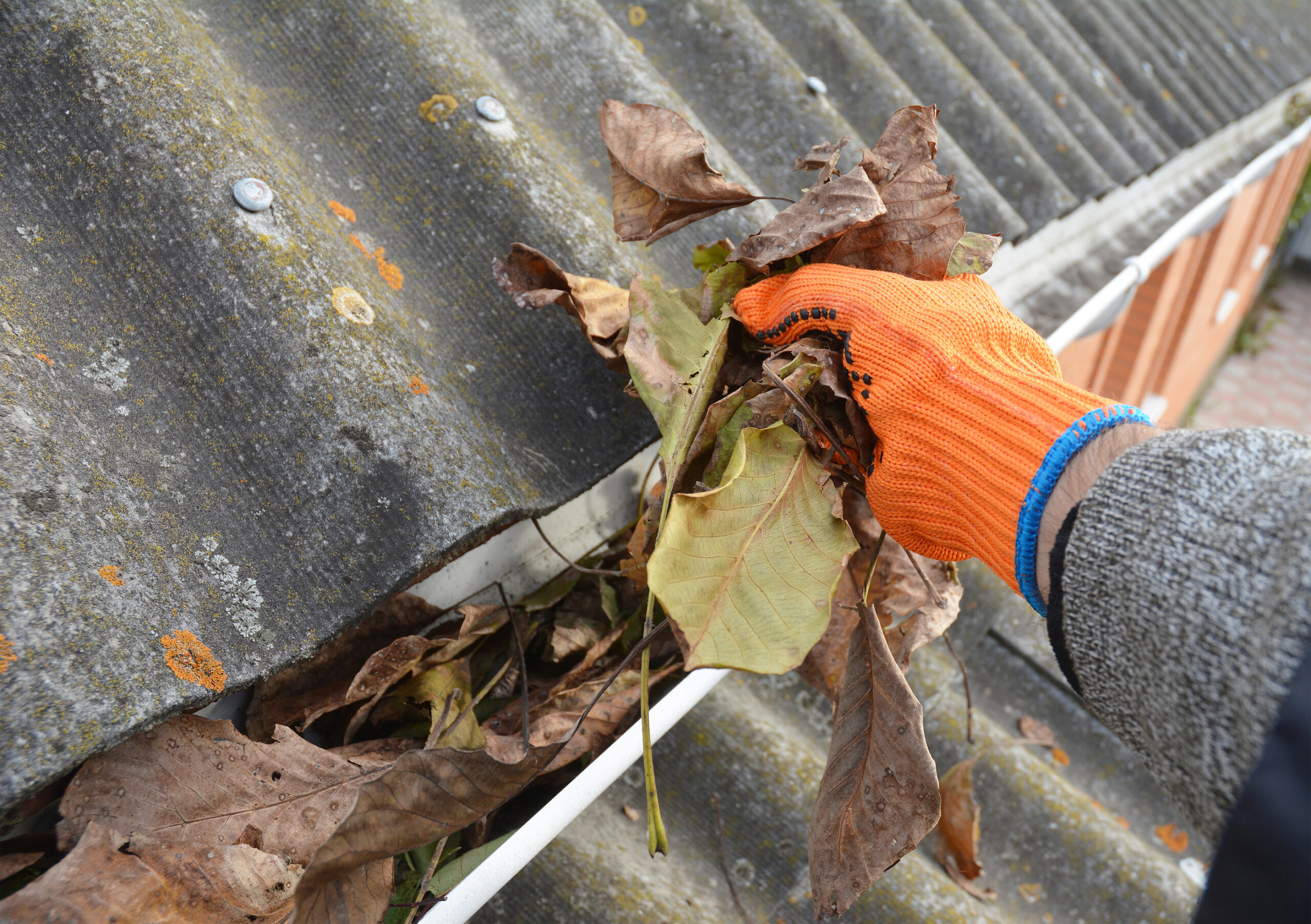5 Ways to Clean Your Gutters Safely

Though many homeowners and building owners find cleaning their gutters once or twice a year difficult, it’s worth the effort. Gutters are one of your home or building’s primary defenses against flooding, mold growth, ice dams, and foundation damage. When dirt, leaves, and other debris clog gutters, rainwater and snowmelt can seep into the roof or run down the siding and cause water damage.
Follow these guidelines for cleaning your gutters safely and efficiently.
Preparation Tips
Follow these tips as you prepare to clean your gutters:
- Wear eye protection. You’ll need sunglasses, glasses, or goggles for any method you choose.
- Put on clothing, shoes, and socks you don’t mind getting dirty or wet. Plan on dealing with soggy debris if you’re using the garden hose or pressure washing method.
- Consider wearing work gloves. You might need to pick up large debris with your hands.
- If you shop for attachments, note the height of your gutters and any obstacles in your landscaping. Gutter cleaning attachments (sometimes called “gutter cleaning wands”) for leaf blowers or garden hoses have long, extendable tubes with curved ends that “hook” into your gutters, removing the need for a ladder. When measuring for length, don’t forget to account for landscaping features like hedges or fence lines.
- Don’t climb on the roof. Avoid walking on your roof unless you’re a roofing installation or gutter cleaning professional. Note: If your property has two or more stories, we recommend hiring a professional.
- Avoid “A” frame ladders. If you need a ladder, opt for one that leans against your siding and ask someone to stabilize it below while you clean.
Leaf Blower Attachment Method
Pros
- You can purchase a leaf blower attachment online or at a hardware store that lets you walk around your property at ground level and clean your gutters.
- This method isn’t messy as long as the debris isn’t wet.
Cons
- Leaf blowers usually aren’t powerful enough to clear dense, packed debris.
- You might unintentionally blow debris in your downspouts, creating a blockage you can’t remove.
This method is perfect for clearing small leaves and twigs. Once you’ve hooked the leaf blower attachment into a gutter, face away from the nearest downspout and start walking slowly around your house. Make sure you’re wearing eye protection and watch out for falling debris.
Garden Hose Attachment Method
Pros
- This telescopic pole attaches to a hose and breaks through minor dirt clogs more efficiently than leaf blower attachments.
- These accessories are usually light, so you can move them around your property without getting tired.
Cons
- You’ll get dirty and wet, no matter how much debris you have in your gutters.
- You might see a spike on next month’s water bill.
Extend the telescopic water-fed pole attachment to the height of your gutters. Stand back a few feet to dodge debris, and walk around the perimeter of your home. Make sure to flush the downsputs so you don’t create any significant blockages as you clean.
Wet/Dry Vacuum Method
Pros
- If you routinely do your own maintenance, you probably already own a wet/dry vacuum that will get the job done.
- Depending on your vacuum’s suction power, this is one of the least messy ways to clean your gutters.
Cons
- It’s hard to see what kind of debris your vacuum is sucking up, so you don’t know if something will clog your vacuum until it happens.
- Many wet/dry vacuums have rollers that are difficult to lug around on uneven terrain.
If your wet/dry vacuum doesn’t come with a long attachment, purchase one online or at a hardware store and install it according to the manufacturer’s instructions. Lift and place it in your gutters and walk around your property. Drain the vacuum often if you notice it’s picking up water.
Gutter Scooping Method
Pros
- This hands-on method allows you to see debris clearly, so you won’t have to guess where to clean next.
- You don’t have to worry about falling debris.
Cons
- You need a ladder you can trust and an assistant to hold it steady on the ground as you work.
- Some gutters are very narrow, so you might be unable to fit a scoop into them.
Get a bucket, work gloves, gutter scoop (or garden trowel), garden hose, and a sturdy, leaning ladder. Use your scoop to break up hard-packed dirt and transfer all debris to the bucket. When you’ve completed a full side, flush your gutters with water to ensure the downspouts are not clogged. You can clear downspout blockages with your scoop or a drain snake, if necessary.
Pressure Washer Method
Pros
- You can blast through even the toughest clogs and blockages.
- You’ll have an opportunity to brighten up your siding or walkways afterward.
Cons
- Due to the hassle of storing, maintaining, and winterizing pressure washers, you probably don’t have one. Rental companies will charge you for usage and fuel, if applicable.
- Your clothes, lawn and roof will be covered with debris. You’ll need to pick up large debris manually and sweep small twigs from sidewalks.
Pressure washer (or power washer) rental companies can pre-install the attachment you’ll need to reach your gutters. Grip the attachment tightly and expect a kickback as you turn it on. Make sure there are no people nearby in case debris gets launched several feet away.
If you have any questions about homeowners or landlord insurance, please call us at 877-576-5200.


